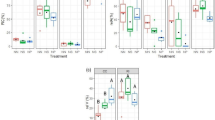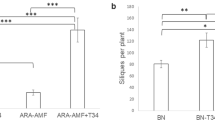Abstract
Arbuscular mycorrhizal (AM) fungi known to cause plant growth depressions in tomato were examined for their biocontrol effects against root rot caused by Pythium aphanidermatum. The main hypothesis was that plant growth suppressive AM fungi would elicit a defence response in the host plant reducing Pythium root rot development. To test this hypothesis a fully factorial experiment was performed with AM fungi (Glomus intraradices, G. mosseae, G. claroideum or nonmycorrhizal), Pythium (± P. aphanidermatum) and harvest (7 and 14 days after pathogen inoculation (dapi)) as the main factors. Two weeks after AM fungi inoculation, roots were challenged with P. aphanidermatum. Variables evaluated at each harvest were root colonization levels of the interacting fungi, plant growth responses, and expression of a plant pathogenesis related protein gene (PR-1). All of the tested AM fungi caused marked growth suppressions, but did not affect PR-1 gene expression or the phosphorous concentration in the host plant. Plants singly inoculated with P. aphanidermatum had an increased PR-1 expression and phosphorous concentration. Among the AM fungi included in the study only G. intraradices reduced the pathogen root infection level, measured both in terms of Pythium ELISA and by recovery on selective media and only at the first harvest. Likewise, P. aphanidermatum root infection reduced colonization levels of G. intraradices, but not that of the two other AM fungi. In conclusion, plant growth suppressive AM fungi may offer plant beneficial traits in terms of biocontrol of root cortical pathogens.


Similar content being viewed by others
References
Boller, T., & He, S. Y. (2009). Innate immunity in plants: an arms race between pattern recognition receptors in plants and effectors in microbial pathogens. Science, 324, 742–744.
Borowicz, V. A. (2001). Do arbuscular mycorrhizal fungi alter plant –pathogen relations? Ecology, 82, 3057–3068.
Campos-Soriano, L., García-Garrido, J. M., & Segundo, B. S. (2010). Activation of the basal defense mechanisms of rice plants by Glomus intraradices does not affect the arbuscular mycorrhizal simbiosis. New Phytologist, 188, 597–614.
Carlsen, S. C. K., Understrup, A., Fomsgaard, I. S., Mortesen, A. G., & Ravnskov, S. (2008). Flavonoids in roots of white clover: interaction of arbuscular mycorrhizal fungi and a pathogenic fungus. Plant and Soil, 302, 33–43.
Dickson, S., Smith, F. A., & Smith, S. E. (2007). Structural differences in arbuscular mycorrhizal symbioses: more than 100 years after Gallaud, where next? Mycorrhiza, 17, 375–393.
Franken, P., & Gnadinger, F. (1994). Analysis of parsley arbuscular endomycorrhiza: infection development and mRNA levels of defence-related genes. Molecular Plant-Microbe Interactions, 7, 612–620.
Gao, L.-L., Knogge, W., Delp, G., Smith, F. A., & Smith, S. E. (2004). Expression of defense-related genes in different types of arbuscular mycorrhizal development in wild-tpyre and mycorrhiza-defective mutant tomato. Molecular Plant-Microbe Interactions, 17, 1103–1113.
Giovannetti, M., & Mosse, B. (1980). An evaluation of techniques for measuring vesicular arbuscular-mycorrhizal infection in roots. New Phytologist, 84, 489–500.
Graham, J. H. (2001). What do root pathogens see in mycorrhizas? New Phytologist, 149, 357–359.
Graham, J. H., & Abbott, L. K. (2000). Wheat responses to aggressive and non-aggressive arbuscular mycorrhizal fungi. Plant and Soil, 220, 207–218.
Graham, J. H., & Eissenstat, D. M. (1998). Field evidence for carbon cost of citrus mycorrhizas. New Phytologist, 140, 103–110.
Johnson, N. C., Graham, J. H., & Smith, F. A. (1997). Functioning of mycorrhizal associations along the mutualism-parasitism continuum. New Phytologist, 135, 575–586.
Khaosaad, T., García-Garrido, J. M., Steinkellner, S., & Vierheilig, H. (2007). Take-all disease is systemically reduced in roots of mycorrhizal barley plants. Soil Biology and Biochemistry, 39, 727–734.
Kormanik, P. P., & McGraw, A. C. (1982). Quantification of vesicular arbuscular mycorrhiza in plant roots. In N. C. Schenck (Ed.), Methods and principles of mycorrhizal research (pp. 37–45). St Paul: American Phytopathological Society.
Lambais, M. R., & Mehdy, M. C. (1993). Suppression of endochitinase, β1,3-glucanase, and chalcone isomerase expression in bean vesicular-arbuscular mycorrhizal roots under different soil phosphate conditions. Molecular Plant-Microbe Interactions, 6, 75–83.
Larsen, J., & Bødker, L. (2001). Interactions between pea root-inhabiting fungi examined using signature fatty acids. New Phytologist, 149, 487–493.
Larsen, J., & Yohalem, D. S. (2004). Interactions between mycorrhiza and powdery mildew of cucumber. Mycological Progress, 3, 123–128.
Li, B., Ravnskov, S., Xie, G., & Larsen, J. (2007). Biocontrol of Pythium damping-off in cucumber by arbuscular mycorrhiza-associated bacteria from the genus Paenibacillus. BioControl, 52, 863–875.
Linderman, R. G. (1994). Role of VAM fungi in biocontrol. In P. L. Pfleger & R. G. Linderman (Eds.), Mycorrhizae and plant health (pp. 1–25). St. Paul: American Phytopathological Society.
Lioussanne, L. (2010). The role of arbuscular mycorrhiza-associated rhizobacteria in the biocontrol of soilborne phytopathogens. Spanish Journal of Agricultural Research, 8, 51–61.
Liu, J. Y., Blaylock, L. A., Endre, G., Cho, J., Town, C. D., VandenBosch, K. A., & Harrison, M. J. (2003). Transcript profiling coupled with spatial expression analyses reveals genes involved in distinct developmental stages of an arbuscular mycorrhizal symbiosis. The Plant Cell, 15, 522–532.
Martin, F. N., & Loper, J. E. (1999). Soilborne plant diseases caused by Pythium spp.: ecology, epidemiology, and prospects for biological control. Critical Reviews in Plant Sciences, 18, 111–81.
Newman, E. I. (1965). A method of estimating the total length of roots in a sample. Journal of Applied Ecology, 3, 139–145.
Nidermann, T., Genetet, I., Bruyere, T., Gees, R., Stintki, A., Legrand, M., Fritig, B., & Mosinger, E. (1995). Pathogenesis-related PR-1 proteins are antifungal. Plant Physiology, 108, 17–27.
Pozo, M. J., & Azcón-Aguilar, C. (2007). Unraveling mycorrhiza-induced resistance. Current Opinion in Plant Biology, l0, 393–398.
Pozo, M. J., Azcón-Aguilar, C., Dumas, E., & Barea, J. M. (1998). Chitosanase and chitinase activities in tomato roots during interactions with arbuscular mycorrhizal fungi or Phytophthora parasitica. Journal of Experimental Botany, 4, 1729–1739.
Pozo, M. J., Azcón-Aguilar, C., Dumas-Gaudot, E., & Barea, J. M. (1999). ß-1,3 glucanase activities in tomato roots inoculated with arbuscular mycorrhizal fungi and/or Phytophthora parasitica and their possible involvement in bioprotection. Plant Science, 141, 149–157.
Smith, S. E., & Read, D. J. (2008). Mycorrhizal symbiosis (3rd ed.). London: Academic.
St-Arnaud, M., & Vujanovic, V. (2007). Effect of the arbuscular mycorrhizal symbiosis on plant diseases and pests. In C. Hamel & C. Plenchette (Eds.), Mycorrhizae in crop production (pp. 67–122). Binghampton: Haworth Food & Agricultural Products Press.
Thygesen, K., Larsen, J., & Bødker, L. (2004). Arbuscular mycorrhizal fungi reduce development of pea root-rot caused by Aphanomyces euteiches using oospores as pathogen inoculum. European Journal of Plant Pathology, 110, 411–419.
Trillas, M. I., & Segerra, G. (2009). Interactions between nonpathogenic fungi and plants. Advances in Botanical Research, 51, 321–359.
Tsao, P. H., & Ocana, G. (1969). Selective isolation of species of Pythophthora from natural soils on an improved antibiotic medium. Nature, 223, 636–638.
van Loon, L. C., Rep, M., & Pieterse, C. M. (2006). Significance of inducible defense-related proteins in infected plants. Annual Review of Phytopathology, 44, 7.1–7.28.
Volpin, H., Phillips, D. A., Okon, Y., & Kapulnik, Y. (1995). Suppression of an isoflavonoid phytoalexin defence response in mycorrhizal alfalfa roots. Plant Physiology, 108, 1449–1454.
Whipps, J. M. (2004). Prospects and limitations for mycorrhizas in biocontrol of root pathogens. Canadian Journal of Botany, 82, 1198–1227.
Acknowledgments
We thank Lone Fink, Anne-Pia Larsen and Steen Meier for excellent technical support and Iver Jakobsen (DTU-Risoe) for providing us with inoculum of AM fungi.
Author information
Authors and Affiliations
Corresponding author
Rights and permissions
About this article
Cite this article
Larsen, J., Graham, J.H., Cubero, J. et al. Biocontrol traits of plant growth suppressive arbuscular mycorrhizal fungi against root rot in tomato caused by Pythium aphanidermatum . Eur J Plant Pathol 133, 361–369 (2012). https://doi.org/10.1007/s10658-011-9909-9
Accepted:
Published:
Issue Date:
DOI: https://doi.org/10.1007/s10658-011-9909-9




